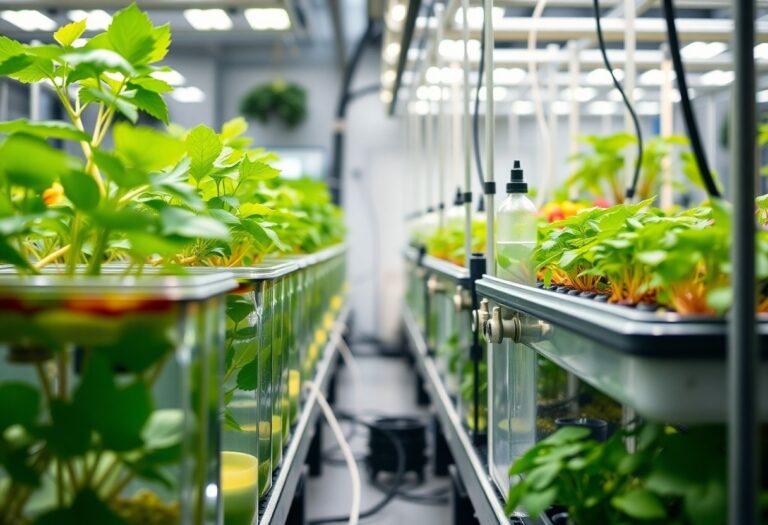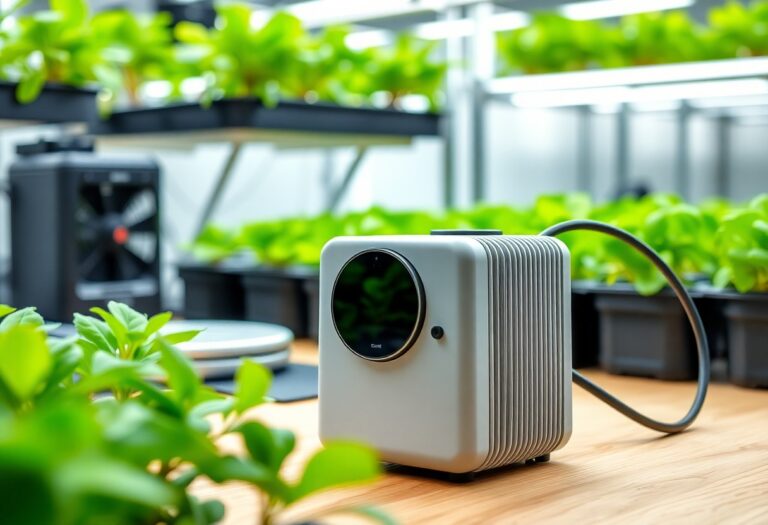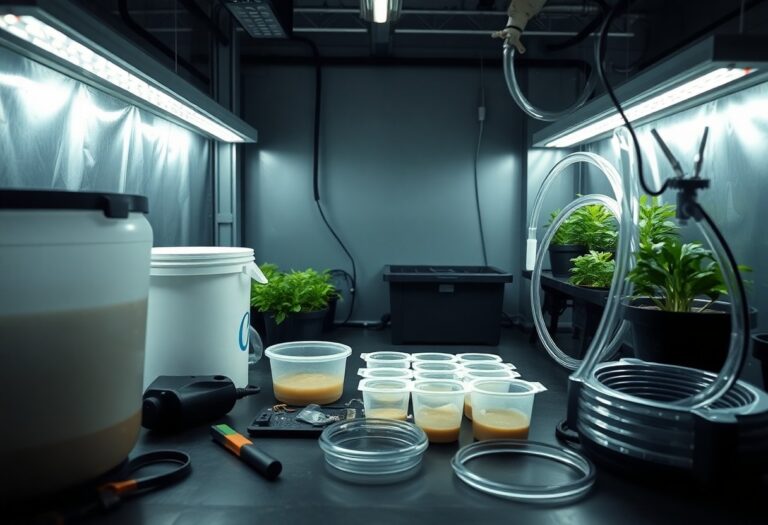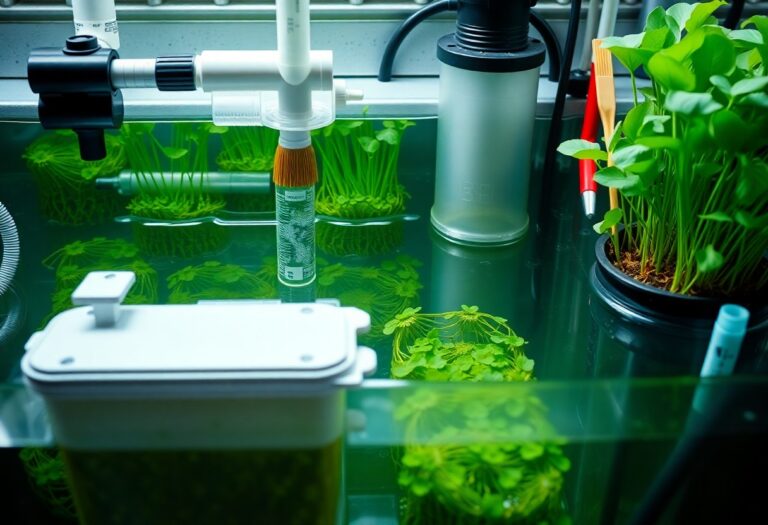Most growers seek to maximize plant health and productivity in their Deep Water Culture (DWC) systems. To achieve this, they must implement specific techniques that enhance nutrient uptake, optimize oxygen levels, and maintain the ideal environment. He or she can utilize high-quality nutrients, manage pH and EC levels, and ensure proper lighting and ventilation to promote robust growth. This guide will provide important strategies to help them achieve higher yields and healthier plants in their DWC systems.
Key Takeaways:
- Choose the right crops that thrive in Deep Water Culture (DWC) systems, such as lettuce and herbs, to maximize growth potential.
- Maintain optimal water temperature and pH levels to create a healthy environment for root development.
- Regularly monitor and adjust nutrient concentrations to ensure plants receive the necessary elements for robust growth.
- Provide adequate light intensity and duration to support photosynthesis and overall plant health.
- Implement proper aeration techniques to enhance oxygen levels in the water, promoting faster root growth and nutrient uptake.
The Foundation: Selecting the Right Setup
Materials That Matter: Choosing Quality Components
Quality components play a significant role in building a reliable DWC system. Growers benefit from selecting food-grade materials that can withstand various environmental factors, such as oxidation and temperature fluctuations. For example, using high-density polyethylene (HDPE) for reservoirs and containers ensures a durable and long-lasting solution. Corrosion-resistant fittings and pumps also enhance the system’s operational longevity, contributing to an overall healthy growth environment.
Additionally, the correct choice of aeration systems, such as air pumps and diffusers, directly impacts oxygen availability for the roots. Investing in a quality air pump rated for larger volumes can prevent root rot and promote vigorous root growth. A small but powerful air pump can produce the necessary dissolved oxygen levels, providing all plants with the care required for optimal development.
The Benefits of Customization: Tailoring Your System
Customization allows growers to optimize their DWC system for specific crops or conditions. By adjusting various components such as the size of the reservoir, the type of aeration system, and the nutrient delivery methods, they can create an ideal environment for their plants. For instance, larger reservoirs might suit plants requiring more water, while smaller, more frequent nutrient doses could be tailored for fast-growing varieties. Additionally, incorporating modular components allows for easier upgrades and adjustments based on growth phases or seasonal changes.
Customization also extends to the layout of the DWC system itself. Growers can choose between different configurations such as a multi-site or single-site setup depending on their available space and the number of plants. This flexibility enables them to optimize light exposure and airflow while managing water resources more efficiently. Tailor-made solutions can lead to improved yields, minimized waste, and an overall enhanced gardening experience.

Nutritional Strategies: Crafting the Perfect Solution
The Importance of pH and EC Levels
In a DWC system, maintaining optimal pH levels typically between 5.5 and 6.5 ensures nutrient availability, as most imperative elements are absorbed more efficiently within this range. An imbalance can lead to nutrient lockout, where plants fail to uptake vital minerals, leading to stunted growth or nutrient deficiencies. Regularly monitoring pH levels with a quality pH meter allows growers to make necessary adjustments using pH up or down solutions to keep their plants thriving.
Electrical conductivity (EC) serves as an indicator of nutrient concentration within the solution, generally ranging from 1.0 to 2.5 mS/cm for most crops. Lower EC values signify a diluted nutrient solution that may not satisfy plant needs, while excessively high values can indicate over-fertilization, introducing toxicity. By periodically checking EC levels with a reliable EC meter, growers can tailor their nutrient solutions to ensure they align with the specific requirements of their crops.
Micro and Macro Nutrients: What Your Plants Really Need
Plants require both micro and macro nutrients for optimal growth, with macro nutrients including nitrogen, phosphorus, and potassium imperative for basic development. Meanwhile, micro nutrients like iron, manganese, and zinc are vital in trace amounts, playing critical roles in metabolic processes within the plant. Establishing a balanced nutrient solution that caters to the specific growth phase is imperative, as each stage demands varying ratios of nutrients. For example, during the vegetative phase, higher nitrogen levels encourage leafy growth, whereas the flowering phase requires increased potassium and phosphorus for budding.
Delivering a nutrient solution that encompasses a full spectrum of elements ensures robust plant health. Many commercially available DWC nutrient formulations contain premixed ratios tailored to various crop types and growth stages. Understanding the specific needs of crops, alongside the growth cycle, allows growers to adjust nutrient concentrations accordingly for maximized growth. A well-considered approach to nutrient management not only enhances overall yield but also elevates the quality of produce harvested.
Water Management Techniques: Optimizing Quality and Frequency
The Art of Aeration: Enhancing Oxygen Levels
In a Deep Water Culture (DWC) system, maintaining high levels of dissolved oxygen (DO) is not just beneficial; it’s imperative for plant growth. Aeration can significantly improve the efficiency of nutrient uptake by plants. One of the most effective methods is employing air pumps and stone diffusers that release fine bubbles across the water surface, maximizing oxygen saturation. Studies suggest that oxygen levels should remain above 6 to 8 mg/L for optimal growth, and growers who achieve these levels often witness up to a 20% increase in yield compared to setups with lower oxygen concentrations.
Techniques such as creating a dedicated aeration schedule can enhance the system’s overall efficiency. By alternating periods of active aeration with quiet periods, the system can oxygenate itself without constant energy consumption, optimizing electricity usage while maintaining sufficient oxygen levels. Zach, an urban farmer from Denver, shared that implementing a dual-aeration strategy led to noticeably healthier root systems and improved crop outputs in his DWC setup.
Preventing Algae Build-Up: Best Practices
Algae can pose a significant challenge in DWC systems, often leading to competition for nutrients and potential plant diseases. By minimizing light exposure, maintaining optimal water temperatures, and utilizing dark or opaque containers, growers can effectively deter algae growth. Additionally, keeping the nutrient solution at a pH of 5.5 to 6.5 also discourages algae proliferation, as higher pH levels can create a more hospitable environment for algal species.
Routine flushing of the system, every four to six weeks, helps to refresh the nutrient solution while dislodging any algae that may be clinging to surfaces. Incorporating beneficial bacteria and enzymes that naturally suppress algal growth can provide an organic solution, allowing for healthier water management without the use of harsh chemicals. Regular monitoring of light conditions around the DWC system, coupled with these methods, can create effective barriers against algal infestations.
Strategies such as introducing beneficial microorganisms into the system also contribute to reducing algae by competing for available resources. Notably, maintaining a consistent water temperature between 68°F and 75°F prevents excessive heat that can foster algal boom, improving overall efficiency in water management. Regular checks and adjustments in nutrient concentrations not only ensure plant health but also act as a deterrent against potential algae build-up.

Temperature and Light Regulation: Finding the Balance
Regulating temperature and light is important for optimizing growth in a DWC system. These factors play a significant role in the overall health and productivity of plants, impacting nutrient uptake and photosynthesis efficiency. By establishing the right environment, growers can enhance plant performance and yield.
Ideal Temperature Ranges: A Guide for Different Stages| Growth Stage | Optimal Temperature (°F) |
|---|---|
| Seedling | 72 – 78 |
| Vegetative | 70 – 85 |
| Flowering | 68 – 80 |
Ideal Temperature Ranges: A Guide for Different Stages
For seedlings, maintaining a temperature range of 72 to 78°F ensures proper germination and development of young plants. A stable environment at this temperature facilitates root establishment and can help prevent stress-related issues. Once the plants transition to the vegetative stage, slightly higher temperatures of 70 to 85°F are ideal. This warmth supports rapid growth and robust leaf development.
As plants move into the flowering stage, a temperature range of 68 to 80°F should be targeted. Cooler conditions during this phase promote healthy bud formation and minimize the risk of heat stress. Slight fluctuations during this stage can be beneficial, but it’s important to avoid extremes to ensure optimal yields.
Harnessing the Power of Light: Choosing the Right Spectrum| Light Requirement | Recommended Spectrum |
|---|---|
| Vegetative Growth | Blue Spectrum (400-500 nm) |
| Flowering Stage | Red Spectrum (600-700 nm) |
Harnessing the Power of Light: Choosing the Right Spectrum
The difference in light requirements at various growth stages is quite pronounced. During the vegetative phase, plants thrive under a blue spectrum of light ranging from 400 to 500 nm. This particular spectrum promotes strong, healthy leaf and stem growth, ensuring that the plants develop a robust structure. Conversely, in the flowering stage, the focus should shift towards a red spectrum (600-700 nm), which is instrumental in stimulating blooming processes.
This intentional focus on the light spectrum aligns directly with plant physiology. For example, a grower using LED lights can select fixtures that provide the necessary blue light during vegetative growth and switch to those that favor red light once plants begin flowering. Utilizing a full-spectrum light source can also alleviate the need for switching fixtures, as they are designed to deliver a balanced spectrum across all growth phases.
Pest and Disease Management: Staying One Step Ahead
Identifying Common Threats: Signs to Look Out For
Pests and diseases can significantly impact the success of any Deep Water Culture (DWC) system. Growers should familiarize themselves with the common signs of infestations or infections. For instance, brown spots or mottled leaves often indicate a fungal infection, while webbing on the undersides of leaves may suggest the presence of spider mites. A sudden decline in plant vigor, coupled with discolored foliage, could point to nutrient deficiencies caused by root rot, which often occurs in overwatered conditions or poorly managed systems. They also need to be aware of pests such as aphids, thrips, and whiteflies, which can weaken plants by sucking out vital sap. Early detection plays a vital role in pest management; growers should conduct regular inspections of their plants and their root systems to catch any issues promptly.
Monitoring the roots within a DWC system is imperative as well. Healthy roots appear white and crisp, while brown or black roots signal potential problems. Shedding roots, or those turning mushy, can indicate diseases like pythium, a common water mold that leads to root rot. They must also stay on the lookout for fungal gnats, which thrive in overly moist conditions and can indicate inconsistent environmental factors in the nutrient solution. Effective management starts with proactive observation, understanding that prevention is often more successful than treatment.
Organic Solutions: Effective Treatments Without Harm
Controlling pests and diseases in DWC systems can be effectively achieved using organic solutions that minimize harm to the plants and the environment. Techniques such as introducing beneficial insects, like ladybugs or predatory mites, can provide a natural defense against unwanted pests. Additionally, organic sprays made from neem oil or insecticidal soap offer non-toxic alternatives for tackling infestations and are versatile enough for indoor or outdoor use. These organic remedies can be used as preventive treatments or in response to early signs of pest activity, promoting a balance in the ecosystem without introducing harmful chemicals.
Emphasizing an organic approach also involves utilizing practices such as crop rotation and companion planting. By rotating crops, growers can disrupt the life cycles of pests, making it harder for them to establish themselves. Companion planting entails placing beneficial plants alongside vulnerable crops, which can repel pests or attract beneficial insects that help with pest control. Moreover, integrating regular use of compost teas can boost plant health, providing robust resistance against diseases while fostering beneficial microorganisms within the DWC system. This holistic approach not only aids in pest and disease management but also builds an overall resilient growing environment.
Harvesting Strategies: Timing is Everything
Recognizing Signs of Readiness: When to Harvest
Observing plant growth in a Deep Water Culture (DWC) system requires attentive monitoring. Plants exhibit certain signs that indicate they are ready for harvest. For leafy greens, a vibrant coloration and a fresh, firm texture typically signal that they have reached peak growth. These plants should be harvested before they start bolting or going to seed, as this can lead to a bitter taste and a diminished yield. On the other hand, fruiting plants such as tomatoes and peppers display their readiness through color change and size. A tomato, for instance, is most flavorful when it attains its full color and firmness, usually indicated by a uniform red or deep orange hue, depending on the variety.
Timing is necessary, and for those cultivating herbs, the best moment for harvest is just before or during the flowering stage. At this point, the oils are concentrated and flavors are entwined more robustly, maximizing the plant’s potential. Observers should also consider the specific variety being grown, as some plants mature faster than others. Monitoring growth cycles can significantly enhance the taste, texture, and overall quality of the final produce when harvested at the right time.
Post-Harvest Care: Maximizing Your Yield
Once the plants have been harvested, the next step involves proper post-harvest care to ensure that the produce retains its quality and extends its shelf life. Immediately after collection, crops should be washed to remove any remnants of nutrient solution, dirt, or pests. Following this, they should be dried thoroughly to prevent rot and mildew. Proper temperature control is vital; vegetables and herbs can be stored in a cool, shaded area to maximize freshness while maintaining optimal moisture levels.
In addition, employing curing techniques for certain crops, such as onions and garlic, can enhance flavors and reduce spoilage post-harvest. Curing involves storing the harvested crops in a dry, ventilated environment where they can develop their flavors while removing excess moisture. This method not only extends the storage life significantly but also intensifies taste, preparing them for market or personal use. For leafy greens, blanching them in hot water briefly before chilling them can help preserve color and nutrients as well.
Packing harvested produce in breathable containers can further help maintain freshness. For instance, crates or perforated bags allow air circulation, reducing moisture buildup and extending shelf life. Cultivators should also consider moderate refrigeration as an option for certain vegetables to prolong their viability while preserving quality. All these methods ensure that growers maximize their yield and deliver the best possible product to the market or their table.

The Role of Data: Monitoring Success with Technology
Essential Tools for Tracking Growth
Employing the right tools can significantly elevate a DWC system’s productivity. Some popular options include digital nutrient monitoring devices, pH meters, and temperature sensors. These instruments allow growers to consistently check vital metrics such as nutrient concentration, pH levels, and water temperature, ensuring that plants thrive in an optimized environment. For example, many modern sensors can connect to smartphones or computers, providing real-time data analytics that can predict trends and identify potential issues before they escalate.
Another crucial tool is the integration of software analytics that can track the growth rate of plants over time. Through the application of growth charts and yield projections, growers can gauge how variables, such as light intensity or nutrient delivery, affect plant performance. Implementing such technology not only enhances productivity but also empowers growers to make informed adjustments with precision based on tangible data.
Data-Driven Decision Making: Adjusting Your Practices
Utilizing data allows growers to engage in informed decision-making that can lead to improved results. Adjustments based on comprehensive data analyses can vary in form. For instance, if sensors indicate that nutrient levels are too high, he or she can modify the nutrient mix or frequency of feeding to avoid plant stress or nutrient burn. Similarly, tracking water temperature tendencies can prompt adjustments to ensure optimal conditions for root health and overall growth.
By regularly reviewing collected data, growers can recognize patterns that traditional observation might miss. Advanced growers might find that certain strains respond better to varied light schedules or humidity levels. Implementing changes based on solid data can lead to a marked increase in yield, as growers tailor their practices to align with the specific needs of their plants, thereby enhancing their overall success in the DWC system.
Community Connections: Learning from Fellow Growers
Networking for Knowledge: Importance of Local Groups
Joining local gardening groups can expose growers to diverse perspectives and practical advice. Individuals can share their experiences with different techniques, nutrient solutions, and pest control methods that have proven effective in their own DWC systems. These community connections often lead to collaborative problem-solving, helping growers troubleshoot issues more efficiently than going at it alone. A recent survey indicated that 75% of successful hydroponic growers attribute their growth and yield improvements to the knowledge exchanged within these local networks.
Moreover, local community groups might host workshops or demonstrations, allowing individuals to visualize different setups or processes. For instance, the community garden associations across various states often organize events where participants can swap plants, seeds, and ideas. Such interactions create a solid support system, making it easier for individuals to stay motivated and inspired throughout their growing journey. This shared commitment can lead to more frequent experimentation and innovation within the growing community.
Online Resources: Websites, Forums, and Blogs to Follow
In addition to face-to-face networking, the digital landscape offers an array of resources perfect for DWC growers. The internet hosts numerous forums and blogs dedicated to hydroponics where she or he can find detailed posts on troubleshooting, nutrient management, and latest trends. Websites like Hydroponics Gardening and Growers Network provide comprehensive guides and expert tips that can enhance a grower’s understanding of DWC systems. Engaging in these online forums allows them to pose questions and receive answers from seasoned experts and hobbyists alike, fostering a sense of community.
Consistently following popular blogs can also provide timely updates on new products, research findings, and innovative practices that are emerging in the hydroponics field. For example, the blog Hydroponics Grower frequently reviews new nutrient brands and equipment, which can assist growers in making informed purchasing decisions. By staying abreast of such resources, individuals can remain competitive and informed, adapting to evolving techniques and technologies in the ever-changing world of hydroponics.
Conclusion
Now that one has explored various strategies to enhance growth in a Deep Water Culture (DWC) system, it becomes evident that attention to detail and systematic management are vital. They should consider optimizing nutrient concentration, maintaining appropriate pH levels, and ensuring sufficient dissolved oxygen. Additionally, monitoring environmental factors like temperature and light exposure can significantly impact plant health and yield. With a focused approach, they can create an ideal environment that fosters rapid growth and ultimately maximizes productivity.
Furthermore, they may find value in implementing advanced technologies, such as automated nutrient delivery systems and environmental controls, to streamline their operations. By doing so, they not only enhance efficiency but also reduce the margin for error. Consistent evaluation and adjustments based on data gathered from their DWC system will help them refine their methods, ensuring that they achieve the best possible results throughout their growing cycle. Adapting these strategies will enable them to cultivate robust, healthy plants in a thriving DWC environment.
FAQ
Q: What is a DWC system?
A: A Deep Water Culture (DWC) system is a type of hydroponic growing method where plants’ roots are suspended in a nutrient-rich water solution. This method allows for efficient nutrient uptake and promotes rapid growth due to increased oxygen availability to the roots.
Q: How can I increase oxygen levels in my DWC system?
A: To enhance oxygen levels, you can add an air pump connected to air stones placed in the nutrient solution. Increasing the aeration in the water ensures that roots receive sufficient oxygen, promoting healthier plant growth. Additionally, consider using a high-quality, high-capacity air pump for optimal results.
Q: What nutrient solution is ideal for DWC systems?
A: The ideal nutrient solution for DWC systems should contain a balanced mix of macro and micronutrients. Look for products specifically formulated for hydroponics, as they provide the right ratios to support plant health during various growth stages. Monitoring the pH level (around 5.5 to 6.5) is also key to nutrient availability.
Q: How often should I change the water in my DWC system?
A: It’s beneficial to change the water in your DWC system every 1-2 weeks to prevent nutrient imbalances and algae growth. Regularly monitoring the water quality will help determine when a change is needed to maintain the health of your plants.
Q: What types of plants grow best in a DWC system?
A: Many plants thrive in DWC systems, especially leafy greens like lettuce and spinach, as well as herbs such as basil and mint. For fruiting plants, consider tomatoes or peppers, though they may require more attention to nutrients and pH levels compared to leafy varieties.
Q: How can I prevent algae growth in my DWC system?
A: To minimize algae growth, ensure that all components of your DWC system are kept clean and lightproof. Use opaque containers for the reservoir to block light, and consider adding beneficial microorganisms or using hydrogen peroxide to treat the water if algae becomes a problem.
Q: What lighting conditions are best for a DWC system?
A: Adequate lighting is paramount for growth in a DWC system. Aim for a light cycle of 12-16 hours of light daily using full-spectrum LED or HID grow lights. Ensuring that plants receive the right amount of light allows for optimal photosynthesis, leading to vigorous growth and development.






Leave a Comment